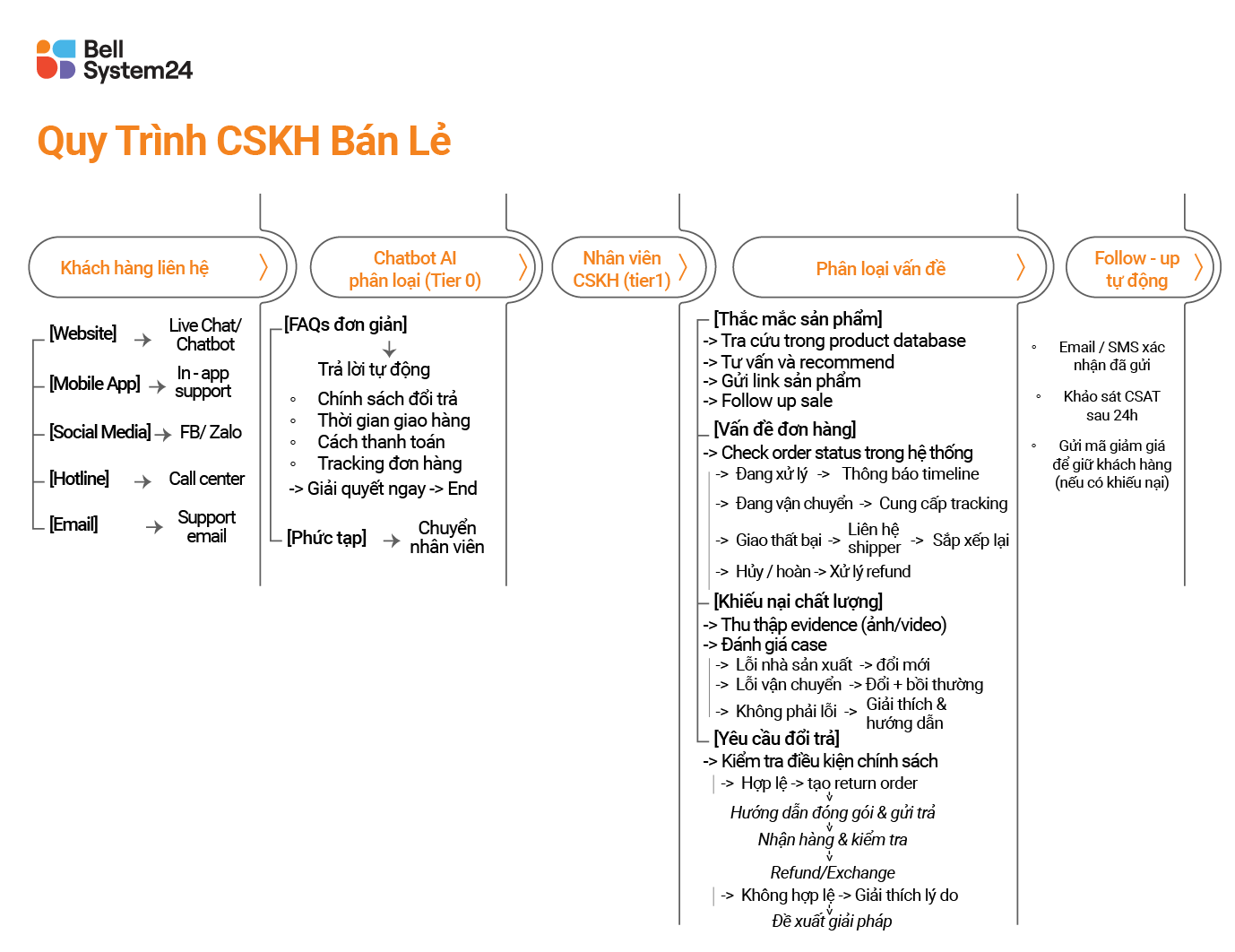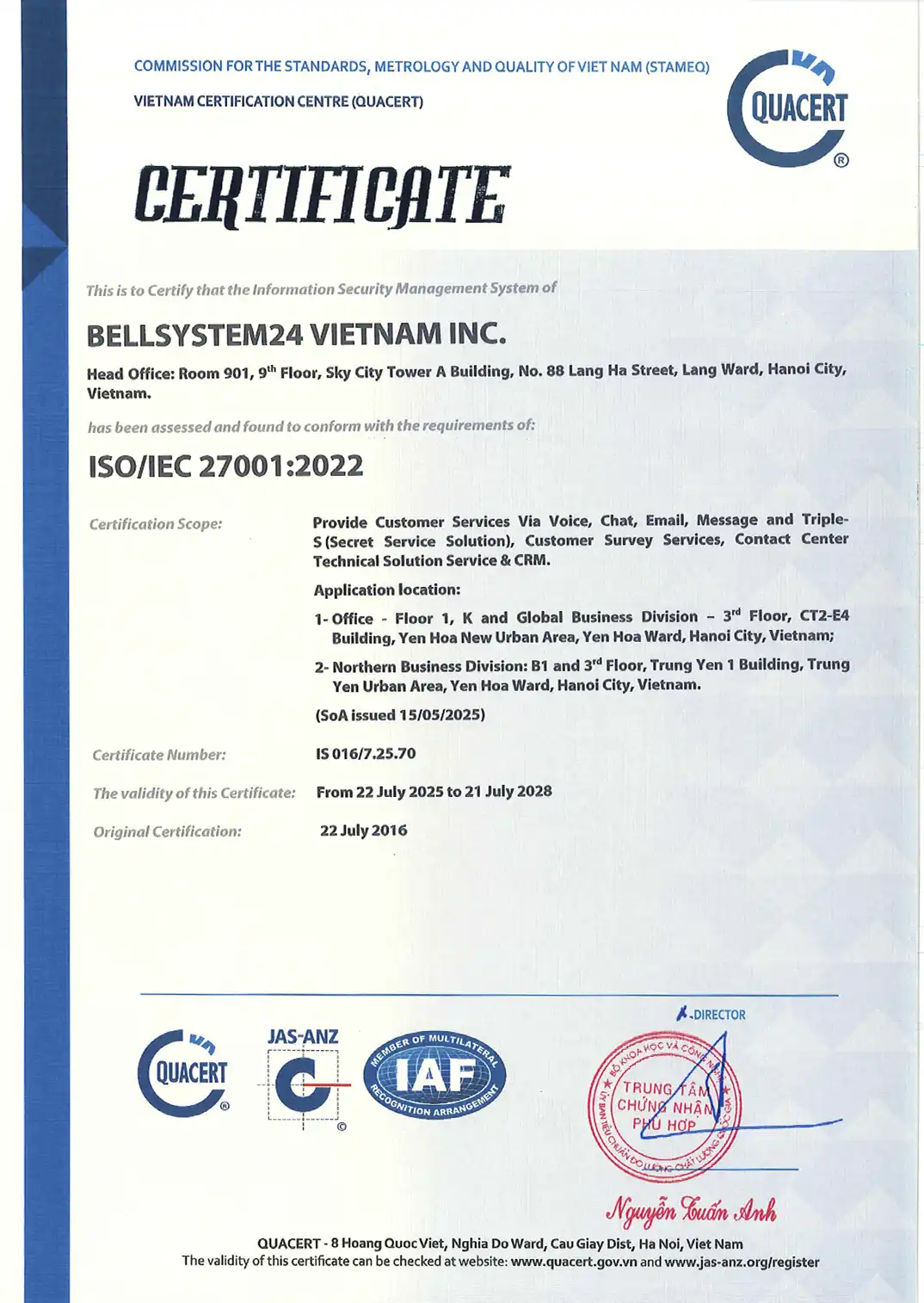In an era where customer experience (CX) has become a critical factor, the Customer Effort Score (CES) is an important metric that helps businesses measure customer experience.
So what is CES? Why is it important? How can you improve this metric? Let's explore it with Bellsystem24 Vietnam!
1. What is CES – Customer Effort Score?
CES (Customer Effort Score) is a metric that measures the level of effort customers must exert to complete a specific action, such as:
- Complete a purchase transaction.
- Search for information about products/services.
- Resolve an issue with the Customer Service Department.
2. Measuring the CES index
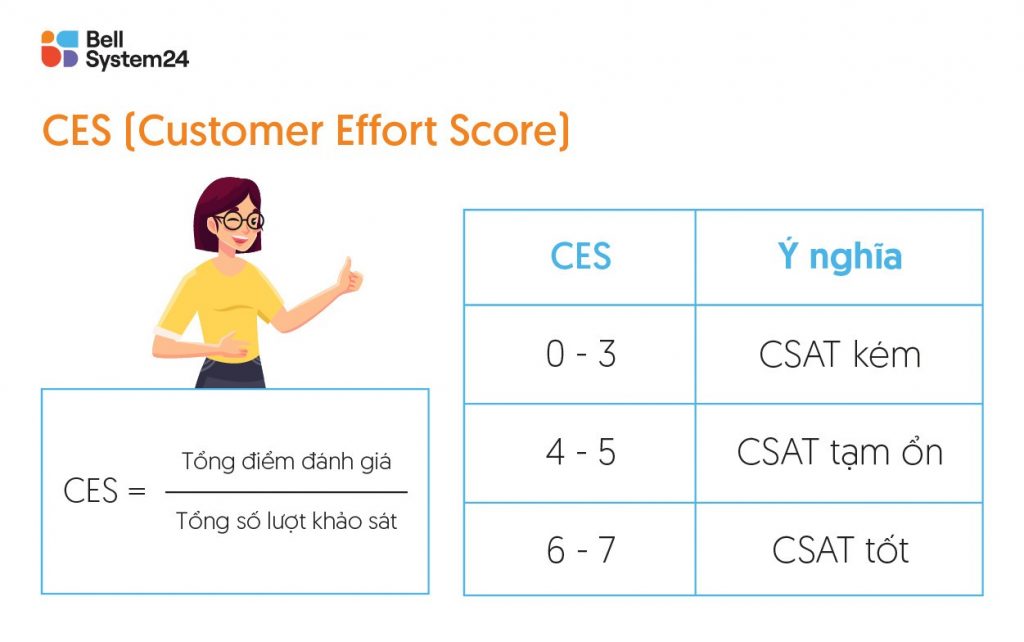
*CSATCustomer satisfaction level
The CES scale typically uses survey questions such as:
How easy do you find it to [complete a specific action]?
Customers will rate on a scale from 1 (Very difficult) to 7 (Very easy). The higher the CES score, customer experience smoothly.
3. Why is the Consumer Electronics Show (CES) an important indicator?
- Loyalty forecast: According to research by Harvard Business Review, 94% of customers who have a smooth experience will continue to make purchases, while only 4% will return if they encounter problems.
- Reduce business operating costs: When customers can easily resolve issues themselves, businesses significantly reduce support costs while increasing the efficiency of their customer service teams.
- Increase conversion rate: A simple purchasing process will help businesses increase revenue, especially in the e-commerce and online services environment.
CES is a highly practical index that directly reflects the convenience experienced by customers, which is particularly important in today's era of technological advancement and the development of shopping applications.
4. STEPS TO MEASURE & ANALYZE CUSTOMER EFFORT SCORE (CES)
To effectively measure and analyze Customer Effort Score (CES), businesses need to follow a structured process, from setting up surveys to analyzing data and optimizing customer experience. Here is a detailed step-by-step guide:
Step 1: Define CES Measurement Goals
CES can be used in many different situations, so the first step is to clearly define the survey objectives:
✔ Customer service evaluation – After customers contact the call center, chat, or email to receive support.
✔ Measure the ease of performing an action – such as placing an order, making a payment, activating an account, or using a product/service for the first time.
✔ Analyze barriers in the customer journey – To identify bottlenecks and improve UX/UI, optimize service processes.
For example: If a business wants to measure the ease of purchasing on its website, the CES survey will be conducted immediately after the customer completes the transaction.
STEP 2: Designing a Standard CES Survey
CES surveys typically consist of simple questions accompanied by a rating scale from 1 to 7 or 1 to 5.
Example of a standard question:
How easy do you find [specific action]?
Common scales:
1️⃣ – Very difficult
2️⃣ – Difficulties
3️⃣ – A bit challenging
4️⃣ – Normal
5️⃣ – Easy
6️⃣ – Very easy
7️⃣ – Extremely easy
Additional question (optional):
- Are you having any difficulties? (Brief description)
- What would you like to improve?
Note:
- Surveys should be concise to avoid wasting customers' time.
- If the CES is low (below 4), additional open-ended feedback should be collected to understand the reasons.
Step 3: Select Channel and Survey Delivery Time
Depending on the measurement objectives, businesses can implement CES surveys through various channels:
E-mail – Send a survey after the customer completes their purchase or receives support from Customer Service.
Live Chat / Chatbot – Send a survey message immediately after the conversation ends.
Application / Website – Display the survey after the customer completes an important action (e.g., completes a transaction).
Survey call – If you want to collect more in-depth data from VIP customers.
Ideal time:
- Immediately after interacting with Customer Service.
- Immediately after completing the transaction, purchase the item.
- After using the product/service for a period of time: Send after 7-14 days to assess the actual usage level.
Step 4: Collect & Calculate CES Points
After collecting the results, calculate the CES using the formula at the beginning of the article.
Step 5: Analyze Results & Identify Bottlenecks
An in-depth analysis is needed to understand the reasons for low CES:
- Which customer group has the lowest CES? (e.g., new users, older customers, mobile users...)
- Which channel has the lowest CES? (For example: email support has a lower CES than live chat...)
- Which step in the process causes difficulties for customers?
Real-world example:
- If the CES is low after the customer places an order → Check if there are any issues with the checkout page (too many steps, interface errors, etc.).
- If the CES is low after contacting customer service → Consider whether the response time is too long, whether the staff provided adequate support, etc.
5. CES SURVEY FORM
Template 1: CES survey after receiving support from Customer Service
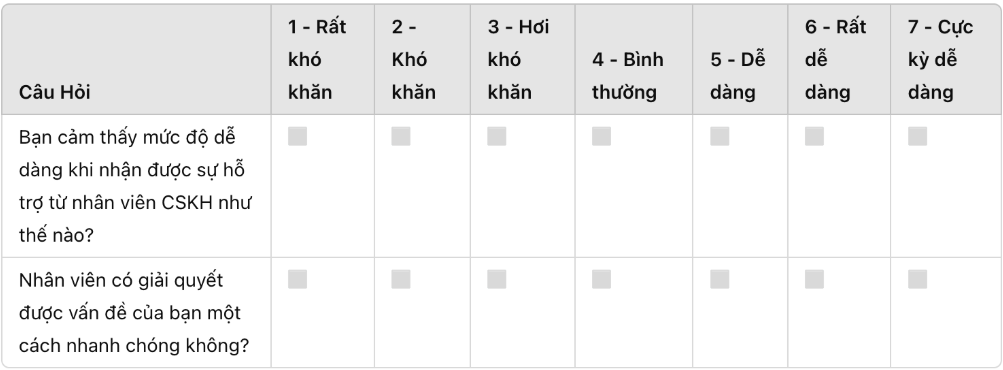
Template 2: CES survey after completing online support
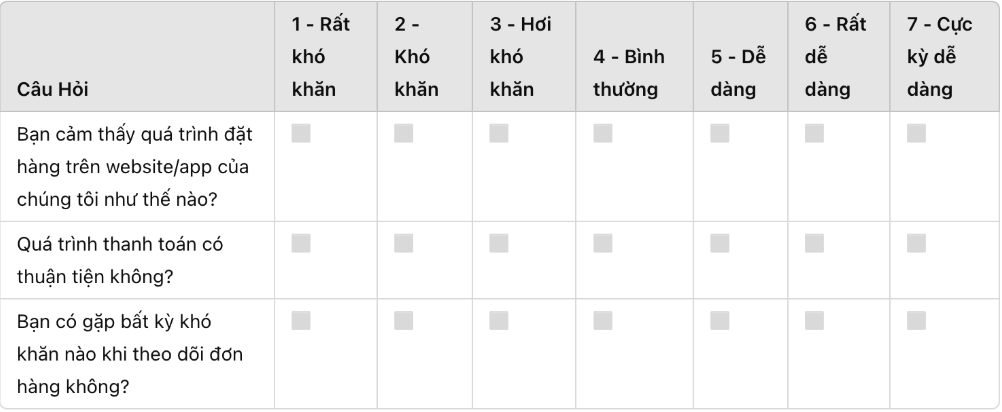
Form 3: Post-use survey of products and services
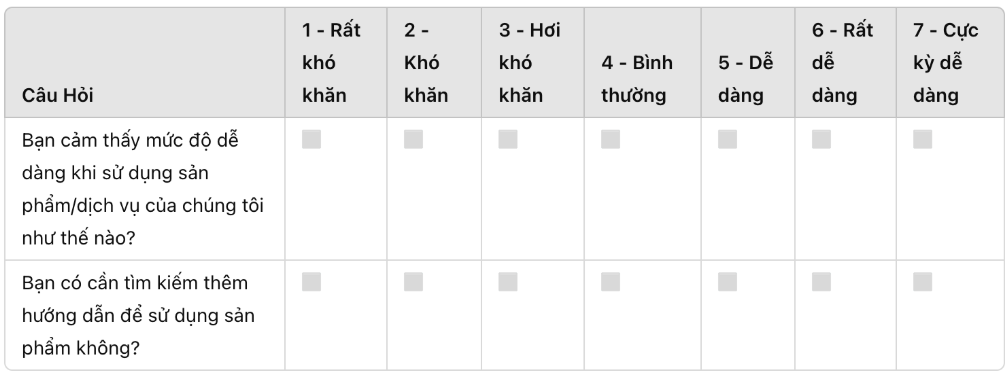
Color 4: Survey after customer cancels service
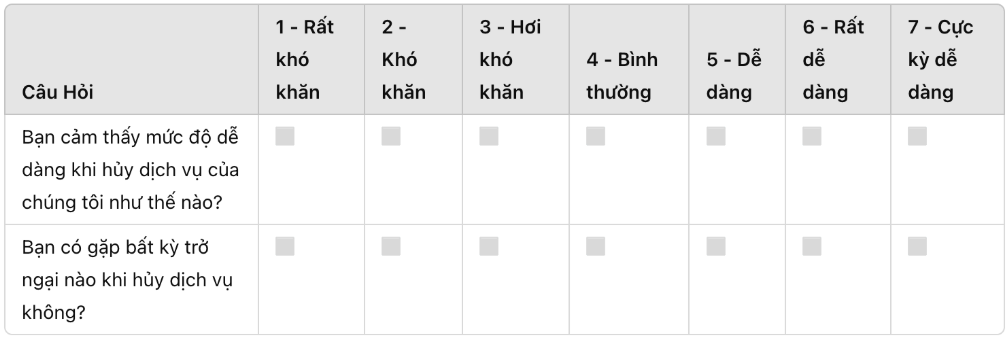
6. Strategies to improve CES
6.1 Optimizing the Customer Service Process
- Integrate an AI Chatbot to provide 24/7 customer support, helping them find answers quickly.
- Improve the website and app interface to make it easier for customers to find information.
- Streamline the support process to avoid asking customers to provide the same information repeatedly.
6.2 Training a professional customer service team
- Emphasize listening, empathy, and problem-solving skills rather than just following procedures.
- Allow employees to handle simple issues without waiting for approval from their superiors.
- Reduce average processing time (AHT) while still ensuring quality support.
See also: Guide to Excellent Customer Care
6.3 Personalizing the customer experience
Deployment personalize the customer experience to create memorable moments.
- Remember customer information so they don't have to repeat it every time they contact us.
- Provide relevant recommendations based on purchase history and user behavior.
- Use self-service technology such as online support centers or smart FAQs.
6.4 Simplify payment and transaction processes
- Limit the number of steps required when purchasing, optimize checkout with just one click.
- Supports various payment methods (e-wallet, QR code, cash on delivery, etc.).
- Send order and transaction confirmations immediately so customers don't have to wait.
Customer Effort Score (CES) is one of the key metrics that helps businesses evaluate the ease of customer interactions. The higher the CES, the greater the customer retention rate.
By optimizing processes, improving service quality, personalizing experiences, and simplifying transactions, businesses can minimize barriers and increase customer satisfaction, thereby improving revenue and brand loyalty.


